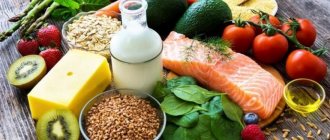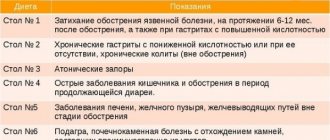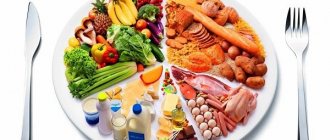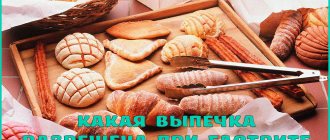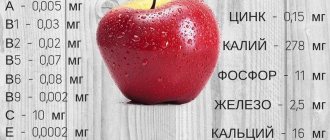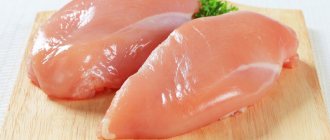Basic diet rules
The diet for acute gastritis has strict rules. The main principle of nutrition is to minimize the load on the digestive tract and provide a gentle regime for the mucous membranes of the stomach. Food should not stimulate the enzyme activity of the gastrointestinal tract. The principles for creating a menu at different stages of the development of the disease differ.
In case of exacerbation, Diet 1A is used with strict restrictions; after the attack has stopped, it is allowed to switch to Diet 1B.
Basic Rules:
- The menu is based on slimy soups (based on vegetables or milk);
- Meat is allowed to be consumed only of lean varieties (the product must be boiled as much as possible; it is introduced into the menu in a ground form);
- When preparing dishes, cooking, stewing or steaming methods are used;
- Dishes can be prepared by baking, but the formation of a crust on food is unacceptable;
- fruits and vegetables can be consumed only after heat treatment;
- it is possible to expand the diet only when the main symptoms of acute gastritis subside;
- after pain symptoms have been relieved, meat and fish can be consumed in pieces, soups can be made richer, and porridges can be made crumbly (methods of cooking do not change);
- You are allowed to consume no more than 6 g of salt per day (the ingredient is added to dishes only after they are cooked).
Types of diet
For each stage of development of acute gastritis, special nutritional rules are provided. In case of severe pain symptoms, therapeutic fasting is recommended (on the first day of exacerbation of the disease).
During this period, you can drink water, weak tea or rosehip decoction. Dietary nutrition begins on the second day of therapy (if the patient has a pronounced tendency to recovery).
Types of dietary programs:
- in the first few days the patient is prescribed a gentle Diet No. 1 A (food should have a liquid or semi-liquid consistency);
- then it is allowed to move on to the nutritional principles of Diet No. 1 B (the diet is expanded, it is allowed to introduce dishes based on ground food products into the menu);
- during the recovery period, you can switch to Diet No. 2 (if the acidity of the gastric juice is reduced) or Diet No. 1 (if the acidity of the gastric juice is increased);
- Diets No. 1 and 2 imply the inclusion of dishes of various consistencies in the diet (meals should be fractional, balanced and taken at least six times a day).
What is Diet number 1
Nutrition for exacerbation of gastritis with low acidity
In case of aggravated gastritis, accompanied by low acidity, the patient is recommended to follow a diet for a full calendar month. If the disease relapses, the patient’s menu may include dishes such as steamed cutlets, pasta, cottage cheese, homemade crackers, herbs, fruits, and weak tea with added milk.
The main goal of the diet is to eliminate the symptoms of inflammation. Subsequently, the patient switches to another type of diet that promotes the production of hydrochloric acid.
Indications
The nutritional programs recommended for acute gastritis have differences and some similarities. The general principles lie in the methods of preparing dishes and the need to ensure minimal stress on the digestive tract.
The diet of different dietary complexes is compiled according to certain rules and implies different types of restrictions.
Indications for different nutrition programs:
- in case of exacerbation of acute gastritis, Diet 1A is recommended (minimum amount of food in the diet);
- acute gastritis after stopping the attack implies Diet 1B (gradual expansion of the diet);
- during remission of the disease, the patient is prescribed Diet 1 (with normal or increased acidity of gastric juice);
- remission of pathology with low acidity implies compliance with the rules of Diet 2;
- after treatment of the disease, the diet can be compiled according to the principles of Diet 5 (the main limitation is the exclusion of foods that can irritate the digestive tract).
Why do you need a diet for gastritis?
“Therapeutic table” is a medical term that means special, rather strict nutrition for the patient. It is generally accepted that a therapeutic diet is, if not the basis for recovery, then an essential component of the treatment of gastritis and other gastrointestinal diseases.
Doctors recommend this diet for patients with:
- acute gastritis (with preserved secretion (normal) or increased);
- gastroduodenitis;
- pancreatitis;
- chronic gastritis;
- atrophic gastritis, reflux gastritis;
- duodenal or gastric ulcer during recovery and other gastrointestinal diseases.
Dietary nutrition helps make food intake harmless: mechanically, chemically, physically. That is, the food is not dangerous either in composition, or in the method of preparation and serving, or in consistency.
What can you eat if you have acute gastritis?
The main cause of acute gastritis is considered to be a violation of the diet. Some foods are irritating to the digestive tract. The consequence is severe pain and deviations in the functional state of the stomach. An attack of the disease can be triggered by overeating, adherence to strict dietary programs, and abuse of light snacks and fast food. Acute gastritis requires a mandatory adjustment of the diet.
Authorized Products
The list of permitted products for acute gastritis includes only ingredients that do not have a negative effect on the functional state of the digestive tract and its mucous membranes. You can prepare dishes only by steaming, boiling, stewing or baking. Some stages of the disease require certain food consistencies.
For example, meat is allowed to be consumed during acute gastritis, but during the period of recovery of the body it can only be introduced into the diet in the form of a soufflé.
Table of permitted products
| Vegetables | Potatoes, beets, carrots, cauliflower, pumpkin, zucchini |
| Porridges and cereals | Rice, semolina, oatmeal, buckwheat |
| Pasta | Noodles |
| Milk products | Milk and cream with reduced fat content, condensed milk |
| Fish | Low-fat fish |
| Meat products | Beef |
| Poultry meat | Turkey, chicken |
| Eggs | Soft-boiled chicken eggs, omelet |
| Bakery products | Dried bread, crackers |
| Beverages | Weak black tea, green tea, compotes, jelly, juices, still mineral water |
Fully or partially limited products
Products included in the list of prohibited options cannot be consumed in acute gastritis, even in minimal quantities. This rule applies to alcohol, carbonated drinks, hot spices and seasonings, fatty, fried, pickled, salty foods. The rich tastes of such products will provoke an exacerbation of the disease.
Table of fully or partially restricted products
| Greens and vegetables | Garlic, celery, radish, cucumbers, legumes |
| Dairy and fermented milk products | Products with a high percentage of fat |
| Meat products | Lard, bacon, pork |
| Sausages | Smoked sausage |
| Poultry meat | Waterfowl meat |
| Mushrooms | All types of mushrooms |
| Dried fruits and nuts | All types of nuts and dried fruits |
| Pasta | All types of pasta |
| Flour products | Dumplings, dumplings, pancakes |
| Bakery products | Fresh bread, wheat bread |
| Sweets | Cakes, pastries, chocolate, confectionery |
| Beverages | Strong tea, carbonated drinks, alcohol, coffee |
Permitted and prohibited products
The diet for exacerbation of gastritis is quite strict. During this period, the following should be completely excluded from the patient’s diet:
- products that promote active secretion of gastric juice - spicy/fried foods, marinades, fatty broths, smoked foods, tea, coffee, mustard, carbonated drinks;
- products that cause gas formation - kvass, baked goods, cabbage, beer, legumes;
- all types of vegetables, citrus juices, alcoholic beverages, onions, garlic and ginger;
- rich broths, difficult-to-digest foods (mushrooms, legumes, fatty meat);
- animal fats, fatty meats (pork, lamb, duck, goose).
What can you eat during exacerbation of gastritis? The patient's diet may include:
Nutrition for gastritis of the stomach with high acidity
- pureed/slimy soups with the addition of milk, eggs, a small amount of butter;
- milk, cream, cottage cheese in the form of soufflé - fermented milk products are temporarily limited;
- beef, chicken, fish in the form of pate/soufflé;
- steam omelette, soft-boiled eggs;
- pureed porridge with milk or water - prohibited: millet, corn, pearl barley;
- jelly made from pureed berries with a sweet taste;
- sweet apples baked in the oven;
- diluted juices from permitted fruits;
- fruit jellies;
- weakly brewed tea with added milk;
- decoction of rose hips.
Strict restrictions on nutrition are imposed only during the period of exacerbation and in case of acute gastritis. After eliminating the pathological symptoms, the patient can eat familiar foods. But he will still not be allowed to use spices, herbs, or hot seasonings. Smoked meats, marinades, and preserves will also remain prohibited.
Menu (power mode)
On the first day of treatment for acute gastritis, therapeutic fasting is recommended. Then the power is restored according to a certain pattern. At different stages of treatment, the patient is prescribed certain types of diet. New foods are introduced into the diet with minimal portions. Hot seasonings and spices for cooking are prohibited.
Second day (Diet 1A):
First breakfast - protein omelet, milk.- Second breakfast - baked apple.
- Lunch - slimy oatmeal soup, fruit jelly.
- Afternoon snack - biscuits, rosehip infusion.
- Dinner - pureed rice porridge with milk, weak tea
- Before bed - a glass of milk.
Third day (Diet 1A):
- First breakfast - semolina porridge, compote.
- Second breakfast - rice water, weak tea.
- Lunch - buckwheat soup, tea with milk.
- Afternoon snack - crackers, rosehip decoction.
- Dinner - steamed chicken soufflé, fruit jelly.
- Before bed - a glass of milk.
Fourth day (Diet 1A):
- First breakfast - soft-boiled egg, tea with milk.
- Second breakfast - rice water, weak tea.
- Lunch - buckwheat soup, tea with milk.
- Afternoon snack - crackers, rosehip decoction.
- Dinner - steamed chicken soufflé, fruit jelly.
- Before bed - a glass of milk.
Fifth day (Diet 1B):
- First breakfast - steamed protein omelette, tea with milk.
- Second breakfast - soft-boiled egg, rosehip decoction.
- Lunch - oatmeal soup, steamed fish soufflé, rosehip decoction.
- Afternoon snack - crackers, weak tea.
- Dinner - fruit jelly, steamed vegetables, steamed meat.
- Before bed - a glass of milk
Sixth day (Diet 1B):
- First breakfast - tea with milk, crackers.
- Second breakfast - crackers with tea.
- Lunch - rice soup with milk, meat soufflé, mashed potatoes.
- Afternoon snack - tea with milk, curd pudding.
- Dinner - rice porridge, compote.
- Before bed - a glass of milk.
Seventh day (Diet 1 or 2):
- First breakfast - buckwheat porridge, tea with milk.
- Second breakfast - cottage cheese casserole, rosehip decoction.
- Lunch - vegetarian soup, boiled carrots, boiled chicken breast, jelly.
- Afternoon snack - crackers with a decoction based on wheat bran.
- Dinner - mashed potatoes with boiled fish, compote, carrots and applesauce.
- Before bed - a glass of milk.
Recipes
Based on the products allowed for acute gastritis, you can prepare many options for delicious dishes. A variety of recipes allows you to make a balanced diet. When preparing dishes, you must follow the main rules of the dietary program - you cannot use the frying method, you are prohibited from consuming fatty meats and fish, salt should be used in a minimum amount. The menu is compiled based on the list of permitted food products.
Therapeutic diet (TABLE) No. 2 (Chronic gastritis with low acidity)
First meal
Rice soup with milk:
To prepare the soup you will need 80 g of chicken, 30 g of rice, 100 g of milk, a chicken egg, and a little butter.- Cook the poultry until tender and pass through a meat grinder.
- Pour boiling water over the rice and cook for two hours. After cooking, strain.
- Mix rice water with chicken meat and bring to a boil.
- Combine milk with chicken egg and add to soup.
- After cooking, add a little butter.
- Salt is added to the soup at the last stage of cooking.
Pumpkin milk soup:
- Boil the pumpkin. Grind the pulp to a puree consistency.
- Boil three glasses of milk. Pour two tablespoons of semolina into the mixture.
- After ten minutes, combine the pumpkin puree with the mixture.
- Re-boil the soup.
Second courses
Beef soufflé:
- To prepare the souffle you will need 100 g of beef, sour cream, egg whites, salt.
- Pass the beef through a meat grinder several times.
- Beat the whites with a mixer.
- Combine the minced meat with whipped egg whites, sour cream, and add a small amount of salt.
- Place the workpiece in a greased mold. Cook by steaming.
Pike perch dumplings:
- Boil 100 g of pike perch (fillet).
- Grind the prepared ingredient.
- Prepare a sauce from 50 g of milk, egg yolk, two teaspoons of flour, a small amount of salt.
- Combine the fish stock with the sauce.
- You can cook the quenelles in a water bath or in a double boiler.
